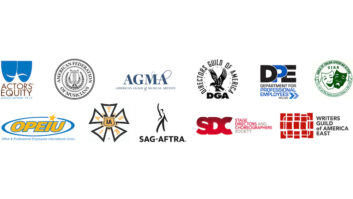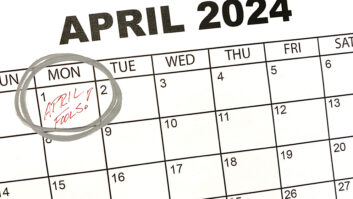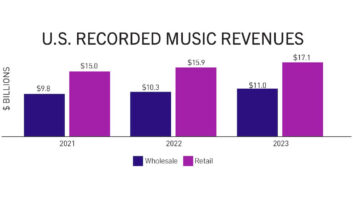A few lucky road dogs are going to get a little something extra in a few months. Their money back. From the Government.
If you’ve been rolling your own tax return or using an H&R Block type of service, you may save enough to pay for several years of taxes just by re-filing the previous year’s tax return with expert help. Tax accountants familiar with our profession may be able to save a significant amount over a self- or franchise-prepared return, while relieving some of the stress. They will know which deductions are allowable and which deductions are red flags that invite an IRS audit. If you are audited, they will hold your hand. Let’s face it, tax laws change almost as often as The Artist Formerly Known As Prince’s sound engineers. It takes expert help to play this game. Most will charge a few hundred bucks if you do your own homework, but can save you many times that in legitimate deductions. Let’s find some of your money.
SELF-EMPLOYMENTBusinesses of all types increasingly use independent contractors to avoid payroll taxes and paperwork. An independent contractor who operates as a sole proprietorship receives a 1099 form at the end of the year instead of a wage earner’s W-2. The 1099 does not list withholdings, because there are none, and an independent contractor must file quarterly estimated withholding taxes (or pay a fine). He or she must also pay their own Social Security and Medicare taxes.
An advantage to being paid as a contractor is that no money is withheld, but the independent contract worker eventually pays a higher overall tax, when the self-employment tax is factored in. Though the self-employed are entitled to more deductions than salaried employees, it’s up to them to document and file for these tax benefits. Most of the deductible expenses of self-employment can be itemized under Schedule C and then deducted from gross earnings. Among the expenses that can be deducted are tools and equipment, overhead expense, transportation and even meals away from home. Let’s look at what else can be deducted.
BUSINESS USE OF YOUR HOMETo deduct home office expenses, a part of your home must be used regularly and exclusively as the principal place of business or as the place where you normally meet and deal with clients. It may also be a separate structure. Gray areas were cleared up by the Tax Relief Act of 1997, which spells out that a home office can be considered the principal place of business if substantial administrative and management activities are performed there. In general, the parts of a home used for both personal and business purposes are not deductible. Even if you meet the “exclusive and regular use” tests, you usually cannot take any deductions for the business use of your home unless you are self-employed.
Deductible expenses can include real estate taxes, mortgage interest, rent, utilities, insurance, depreciation, painting and repairs. The amount depends on the percentage of your home used for business. To figure this percentage, simply divide the number of square feet used exclusively for business by the total in the home. The business portion of each expense is figured by applying this percentage. Renters can deduct the business portion as an indirect expense. Home owners cannot deduct the fair rental value of the home office, but can claim depreciation.
Phone expenses are not part of your home office deduction, and are separately deductible; but if you maintain a home office, you can’t deduct the basic monthly charge for the first line as a business expense. You can, however, deduct business-related charges, such as long-distance calls for business, or for call answering, call waiting and call forwarding services. You can also deduct an entire second phone line if it is used exclusively for business, and the cost of any additional business lines, such as dedicated fax or modem lines.
The business portion of a homeowner’s insurance policy is also part of the home office deduction as an indirect expense, but additional coverage directly related to the home office is treated as a direct expense. You may, for example, carry special coverage for home office equipment. In fact, if you don’t have special coverage, you should check your homeowner’s policy. You might think your computer is covered, but some policies exclude business equipment.
A home security system for the entire home can give rise to two types of write-offs. First, the business portion of your monthly monitoring fees are indirect expenses. Second, the business portion of the cost of the system itself may be depreciated. This depreciation also becomes part of your indirect expenses.
If the gross income from the business use of a home is less than the total business expenses (an operating loss), the deduction for certain expenses is limited. However, the nondeductible amount can be carried forward as part of next year’s expenses. Be warned, though, that operating at a loss for even a year is an invitation to an IRS audit.
A canceled check, along with a bill, generally establishes the cost of a business item. However, the check alone does not prove a business expense without other evidence of its business purpose.
EXPENSE THAT VANFor business use of your car, you can use a standard mileage allowance to figure your deduction instead of keeping a record of all your expenses. This 31.5 cents-per-mile (1999) allowance takes the place of a deduction for gasoline, oil, insurance, maintenance and repairs, vehicle registration fees and depreciation. Towing charges for the car are still separately deductible, and parking fees or tolls are also allowed in addition to the standard mileage allowance. Deductible parking fees include those incurred to visit clients and customers or while traveling away from home on business. Parking fees to park your car at home or at your place of work are nondeductible personal expenses, as are parking tickets and traffic fines, even if they were incurred in the course of business-related travel. At 31.5 cents per mile, 10,000 miles (100 miles round-trip per week) gets a deduction of $3,150. This may be more than your van is worth.
The actual expense method allows deduction of all out-of-pocket costs for operating a car for business, plus an allowance for depreciation. A vehicle that is paid off and needs few repairs may offer more tax advantage on the mileage method, while it might be better using actual expenses with a newer vehicle. Changing to the standard mileage allowance in subsequent years is prohibited after using the actual expense method, but starting with the mileage method, you can always use the actual expense method in later years.
For individuals, interest on a car loan may or may not be deductible depending upon employment status. If you are an employee who uses a car for business, interest on a car loan is treated as nondeductible personal interest. However, if you are self-employed, the interest may be treated as business interest.
Regardless of the method chosen, certain record-keeping requirements apply. You must keep track of the number of miles you drive each year for business, as well as the total miles driven each year. You must also record the date of the business mileage, the designation of the business travel and the business reason for the car expense. You should keep a travel log in which you record the date, destination and purpose of each business trip, and the number of miles driven. Be sure to note the odometer reading on January 1 each year.
COMMUTINGThe cost of commuting is generally a nondeductible personal expense. Bus or train fare and gas for your car, tolls and parking fees are all nondeductible, even if the commute is long or you work with a cell phone or computer on the way. But there are a few exceptions that make certain commuting expenses deductible. If you have a regular place of business, but work at temporary locations on a short-term or irregular basis, then you can deduct the cost of travel between them, particularly if you travel out of town. If you have a legitimate home office, then the cost of traveling from your home to do business is deductible.
SELF-EMPLOYED HEALTH INSURANCE DEDUCTIONAs part of the new Health Insurance Portability and Accountability Act, the health insurance deduction for the self-employed was increased, and a 50% deduction is allowed next year, going to 100% by 2007. This may be the year to shop for health care if you’re not covered. (At four bucks a pack, the money you save by quitting smoking will almost pay for your health insurance.)
MEALS AWAY FROM HOMEIf the nature of a business trip requires an overnight stay, the cost of meals on the trip is deductible, but there is a 50% limit. This limit also applies to the “standard meal allowance” and is taken into account on tax forms. When deducting meal costs, the choice is to either keep track of all actual costs, or use the standard meal allowance set by the IRS. The dollar amount of the standard daily meal allowance is set by the government and is determined by where you stop to sleep or rest. In most of the United States, the amount is $30, and in cities designated as “High Cost,” the daily amount is higher (e.g., $34 for Mobile, $38 for Memphis, $42 for Manhattan and $46 for L.A. and San Francisco.). Remember, the deduction is legal, even if they fed you at the gig!
ESTIMATED TAXESSelf-employed individuals must estimate their income tax for the coming year and pay it in quarterly installments. Unlike live sound income, quarterly payments are equal over the four seasons. Each quarterly payment is about one-fourth of the previous year’s tax, but a penalty is not usually assessed until you owe $1,000. The penalty is currently 9% APR on the amount that was underpaid. If you are owed money from last year’s taxes, you may apply some or all of it toward next year’s estimated payments, reducing the pressure to come up with those large lump sums.
AMEND A PRIOR TAX RETURNIf you made a mistake or neglected to claim expenses on a prior tax return, you may file an amended return and receive a refund. Tax returns can usually be amended up to three years from the original due date, but amending a tax return can produce unwelcome ramifications. As always, a qualified tax professional should be consulted. In my case, after the first filing, my accountant and I went back and found thousands of dollars that had been thrown away the previous year and rescued them via an amended return.
SINCE YOU ALREADY READ MIXI’m probably preaching to the choir here, but perhaps you have a friend who needs to start the new millennium right, fiscally speaking. There are literally dozens of ways a tax accountant can help you save money. Moving expenses when changing jobs, the cost of looking for a new job, and college loan interest payments are just a few that are often overlooked. People in the sound business prefer experienced professional specialists, and the same should go for taxes. Beyond the stress that you can shed next April, the money spent getting professional help may be returned many times over in savings. But don’t wait until April, when both you and the best tax people are all booked up.
Audio and video tapes related to business skills
Business-related magazines and books
Education to improve business skills
Seminars and trade shows
Casualty and theft losses
Promotion and publicity
Commisions paid
Consultant fees
Business association dues
Office Supplies
Online Computer services related to business
Postage
Telephone calls away from the business
December 26 Boxing Day. Ship everything that you didn’t dare send by UPS before Christmas.
December 30 Last day to back up your computer. Don’t laugh-it’s just a good idea.
December 31 Last day for most transactions that can affect your 1999 tax position. New equipment should be placed into service before the end of the year to be deductible. Use it on that New Year’s Eve gig.
January 1 Write down the mileage of vehicles used for business. Update and close out vehicle logs from last year, and start new ones.
January 18 Last quarterly installment of 1999 estimated tax due.
February 15 W-2 and 1099 forms should have been received.
April 17 Last day to file 1999 income tax return, or request a four-month extension. Plus the first installment of your 2000 estimated tax is due, usually paid with filing. Also this is the last date to open and deposit funds into a 1999 IRA account. While there’s no immediate tax benefit for the newer Roth IRA, it offers untaxed returns at age 60, while making exceptions for certain types of early withdrawal, like first-time home buyers after five years.
June 15 and September 15 Second and third installments of your estimated taxes are due.
1. Ask local acquaintances in your line of work who they use for a tax accountant. Book an appointment early. Popular tax accountants may raise their rates after March 15.
2. Start collecting receipts. Use either the filing cabinet or the shoe-box method.
Take last year’s calendar, check stubs, invoices and credit card statements and build a journal of expenses. Reconstruction of business expenses is valid. Documentation needn’t be perfect, but it has to be reasonable. The loss of a receipt does not mean the loss of a write-off. Every legitimate business expense should be deducted. If an audit occurs, the records of expenses will have to be reconstructed in the absence of a receipt. There is no question that IRS wants proof of everything claimed and they prefer receipts, but they also accept calendars and daily planners as documentation. The key is to keep as many records as possible to substantiate your claim.
Receipts of $75 or less are often not necessary, but you must have a journal that tracks these expenses. This log should detail what the expenditure was for, the amount, when and where the purchase was made, and its business purpose. The reconstruction of business expenses, while not often allowed at typical tax-prep franchises, is nevertheless an allowable method of expense accounting.
3. Review a list of all your business-related expenses with a professional tax accountant.
4. Prepare a list of year-end transactions-and don’t wait until the last day.Income and expenses can be shifted from one year into the next depending on how payables and receivables are handled. You might get paid in January for services in December, putting that income into next year.
Leasing allows the financing and amortization of all acquisition costs (including shipping, installation, extended warranty and sales tax) over the life of the lease, or the full tax benefit of a lease can be taken in the year the purchase is put into service. Now is an excellent time to lease capital equipment, lock in on a low, fixed rate and free up lines of credit for more pressing needs as they arise.







